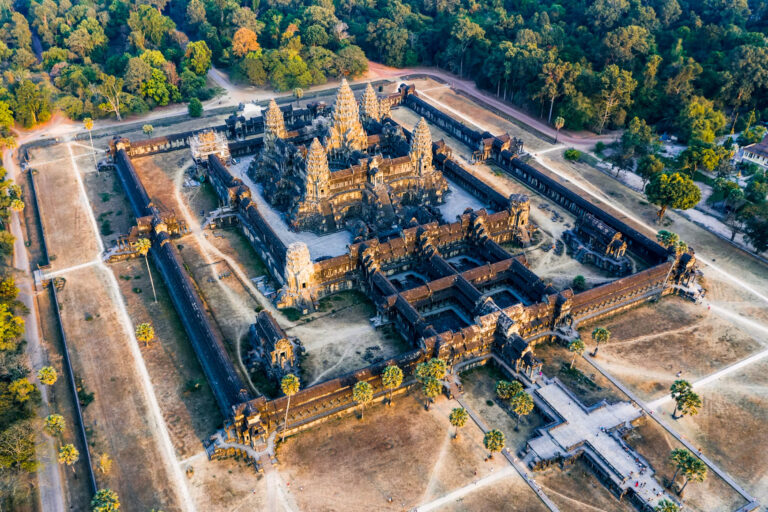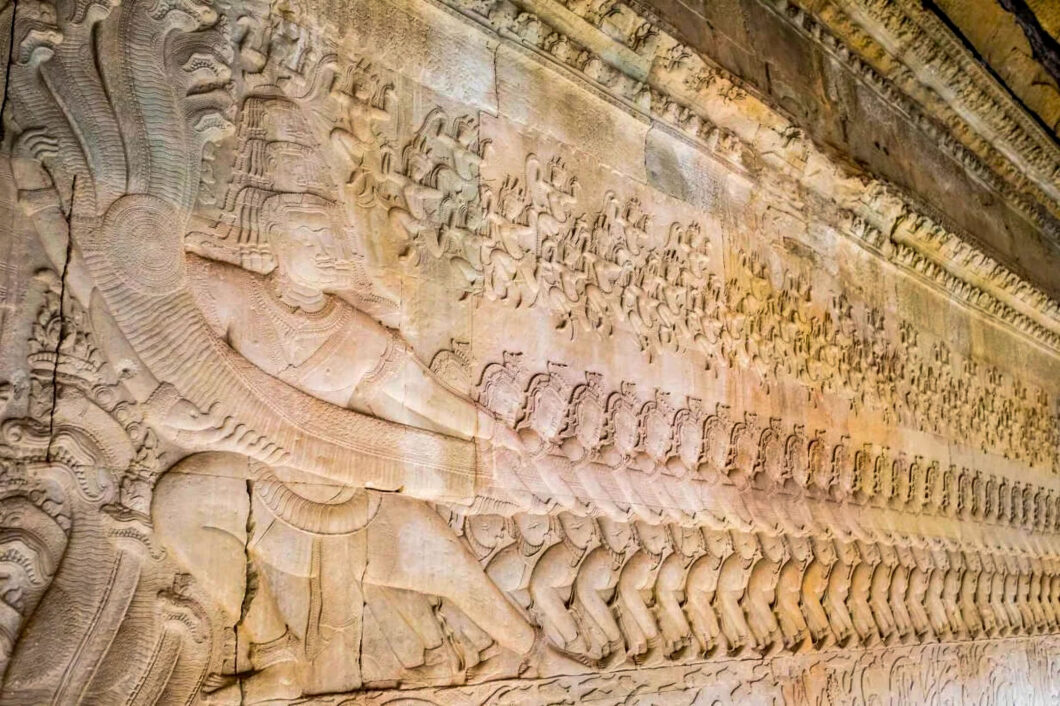In Angkor Wat, there are eight bas-reliefs adorning this incredible world heritage site, covering a total area of 1,200 square meters. Each of them intricately captures essential aspects of Hindu mythology. Among these, a particularly noteworthy bas-relief is known as the Churning of the Sea Milk. Spanning 160 feet (49 meters), this bas-relief vividly depicts a crucial theme in Hindu mythology—the Churning of the Sea of Milk. In this scene, devas (Gods) and asuras (demons) collaborate to churn the cosmic ocean of milk, aiming to obtain the elixir of immortality, Amrita.
Long ago, Devas (Gods) and Asuras (Demons) were locked in a fierce battle for control of the world. After many years, the Asuras, led by Valin, emerged victorious, taking over the universe.
Feeling powerless and fearing the potential harm the mighty Asuras could cause, the defeated Devas sought help from Lord Vishnu. In their desperation, Lord Vishnu advised them to make peace with the Asuras and collaborate on churning the Kshira Sagara, the Ocean of Milk, to find the Amrita, a lost elixir of immortality. Approaching the Asuras with this idea, the Devas proposed a partnership. The Asuras agreed, with the condition that they share the Amrita once it's found. Both groups joined forces to begin the churning process.
Being gods and demons, an ordinary churning rod wouldn't suffice. Instead, Mount Mandara was enlisted to serve as the churning rod, and the serpent king Vasuki, a naga coiled around Shiva's neck, became the churning string.

Vishnu was aware that Vasuki would emit poisonous flames when twisted and pulled. So, he advised the Devas to hold the tail end of the serpent, without revealing the reason. Initially, the Devas held the head end, while the Asuras held the tail end. This sparked anger among the Asuras, believing the lower part of an animal to be less pure. They insisted on holding the head side, playing into Vishnu's reverse psychology.
The Asuras insisted on holding the head of the snake, while following Vishnu's counsel, the Devas agreed to grasp its tail. With Asuras and Devas at either end of Vasuki, they began pulling him back and forth, twisting Mount Mandara and churning the waters of the primordial ocean into milk. This is the moment depicted in the relief at Angkor Wat.

As Mount Mandara was placed in the ocean, it started to sink. Vishnu, taking the form of Kurma (a turtle), came to the rescue, supporting the mountain on his shell. The Asuras were affected by the fumes emitted by Vasuki, but despite this, both factions persisted in pulling Vasuki alternately, causing the mountain to rotate and consequently churning the ocean.
As the ocean churned, treasures surfaced, including the precious Amrita. However, the fragile peace between gods and demons shattered, and the Asuras claimed the Amrita for themselves. In their desperation, the Devas sought help from Lord Vishnu.
Answering their plea, Vishnu transformed into the enchanting goddess Mohini. She charmed and tricked the Asuras, convincing them to hand over the Amrita. Mohini then discreetly returned the elixir to the Devas. Empowered by the Amrita, the Devas finally defeated the disheartened Asuras and emerged victorious.

The Worldly and The Divine
This story is often seen as an allegory illustrating the superior qualities embodied by the Devas. Asuras are depicted as being driven by worldly desires such as lust, greed, and ego. On the contrary, Devas are portrayed as individuals more inclined towards seeking knowledge and understanding spiritual truths. This differing orientation is the sole factor distinguishing Devas from Asuras, akin to the concepts of angels and demons. The conflicting values of the Devas and Asuras become even more explicit in the story, as Vishnu enters the bodies of each. In the Asuras, Vishnu embodies the principle of passionate activity, while in the Devas, he represents goodness.
人们常将甘露解释为智慧的隐喻,喝甘露的行为被比喻为感知上帝。天神和阿修罗在搅动山的过程中贡献了同样的努力,然而最终只有天神能享用甘露。这个信息很明确——只有天神能得到甘露;只有善良者能领悟上帝。
